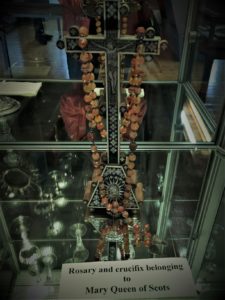
The Rosary: Part 3
Do most Catholics pray the Rosary every day? No. “Devout Catholics” (Monks, Nuns, etc.) often pray a daily Rosary. “Lay Catholics” more often pray through it once a week.
Is the Rosary part of the Mass? No. It is not a regular part of Mass, but it is common practice for a group of people to gather before Mass to pray a Rosary. When a Rosary is prayed as a group, it is often structured as a “Call and Response.”
How long does it take to pray the Rosary? Average time is around 15-20 minutes.
Is the experience the same for all Catholics who pray the Rosary? No. While the memorized prayers are the same for all Catholics, the process of meditating on the Mysteries is personal. As a person grows in their faith, their reflections on Scripture will also change.
Do Rosaries have to be certified by the Catholic Church? No. Making your own rosary is not a problem.
What is the average cost of a rosary? The price range varies greatly, but on the lower end, a rosary can be purchased for under $15.
Where did the first Rosary originate? There is not one clear answer to this question. The use of prayer beads has been noted since the earliest centuries AD. Even the legend of St. Dominic’s connection to the Rosary is debated, although that would trace the Rosary to the early 13th century. At that time, it is believed the Rosary beads were used as a witnessing tool to tell about the life, death, and resurrection of Jesus.
What is the Feast of the Holy Rosary? Celebrated on October 7th, this is the commemoration of the Battle of Lepanto. In 1571, a fleet of Catholic maritime forces battled against the Ottoman Empire along the western shore of Greece. Knowing their forces were outnumbered, Pope Pius V called for the Catholic nations to pray the Rosary on behalf of the navy. The Ottoman Empire was defeated and did not advance further into Europe.
Who wrote the “Apostles’ Creed”? Again, no one knows for certain. Though similar to the “Nicene Creed,” this statement of belief originated earlier and is more directly attributed to the teachings of the Apostles after Pentecost.
In summary, many people looking thought a Protestant Lens, will see two troublesome issues with praying the Rosary. First, the emphasis placed on Mary (another topic for another day). Second, the sheer amount of rote and repetition.
Looking through a Catholic lens, Archbishop Fulton Sheen has often been quoted as describing the Rosary in this way:
“Each time it means something different because, at each decade, our mind is moving to a new demonstration of the Saviour’s love….The Rosary is the best therapy for these distraught, unhappy, fearful, and frustrated souls, precisely because it involves the simultaneous use of three powers: the physical, the vocal, and the spiritual, and in that order….The Rosary is the book of the blind, where souls see and there enact the greatest drama of love the world has ever known; it is the book of the simple, which initiates them into mysteries and knowledge more satisfying than the education of other men; it is the book of the aged, whose eyes close upon the shadow of this world, and open on the substance of the next. The power of the Rosary is beyond description.”
Protestants would say you don’t need a rosary to experience this and perhaps many Catholic would agree. But, for many Catholics, it is a valuable tool in their faith journey. And, as we journey together, may we remember the anchor of all grace and truth is Jesus.

